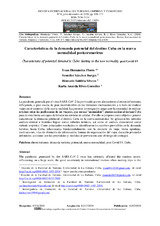Mostrar el registro sencillo del ítem
Características de la demanda potencial del destino Cuba en la nueva normalidad postcoronavirus
| dc.contributor.author | Hernández Flores, Yoan | |
| dc.contributor.author | Sánchez Borges, Yennifer | |
| dc.contributor.author | Saldiña Silvera, Bismario | |
| dc.contributor.author | Rives González, Karla Ananda | |
| dc.date.accessioned | 2021-01-12T12:49:10Z | |
| dc.date.available | 2021-01-12T12:49:10Z | |
| dc.date.issued | 2020 | |
| dc.identifier.issn | 2530-7134 | |
| dc.identifier.uri | http://hdl.handle.net/10396/20963 | |
| dc.description.abstract | La pandemia generada por el virus SARS-CoV-2 ha provocado graves afectaciones al sector del turismo, influyendo, a gran escala, la gran incertidumbre en los visitantes internacionales a la hora de realizar viajes en el contexto de la nueva realidad. La presente investigación surge ante la necesidad de realizar estudios sobre las preferencias de los viajeros, que en una “normalidad”, puedan arribar al destino Cuba para de esta forma ser capaz de brindar un servicio de calidad. Por ello se propone como objetivo general caracterizar la demanda potencial al destino Cuba en la nueva normalidad. Se aplicaron los métodos análisis-síntesis e histórico-lógico como métodos teóricos, así como el análisis documental como método empírico. Como principales resultados se identificaron los cambios previsibles en la demanda turística hacia Cuba, relacionadas fundamentalmente, con la decisión de viaje, fecha oportuna, motivaciones, vías de obtención de información, formas de organización del viaje, duración promedio del mismo, así como con las prioridades y medidas de prevención ante el riesgo de contagio. | es_ES |
| dc.description.abstract | The pandemic generated by the SARS-CoV-2 virus has seriously affected the tourism sector, influencing, on a large scale, the great uncertainty in international visitors when making trips in the context of the new reality. This research arises from the need to carry out studies about the preferences of travelers, who in a “normality”, can arrive at the Cuban destination in order to be able to provide a quality service. Therefore, it is proposed as a general objective: to characterize the potential demand to Cuba destination in the new normal. Analysis-synthesis and historical-logical methods were applied as theoretical methods, as well as documentary analysis as an empirical method. The main results were the foreseeable changes in tourist demand to Cuba, mainly related to the decision to travel, the appropriate date, motivations, ways of organizing the trip, average duration of the trip, as well as the priorities and prevention measures against the contagion risk. | es_ES |
| dc.format.mimetype | application/pdf | es_ES |
| dc.language.iso | spa | es_ES |
| dc.publisher | UCOPress | es_ES |
| dc.rights | https://creativecommons.org/licenses/by-nc/4.0/ | es_ES |
| dc.source | Revista Internacional de Turismo, Empresa y Territorio (RITUREM) 4(2), 178-193 (2020) | es_ES |
| dc.subject | Turismo | es_ES |
| dc.subject | Demanda turística potencial | es_ES |
| dc.subject | Nueva normalidad | es_ES |
| dc.subject | Post Covid 19 | es_ES |
| dc.subject | Cuba | es_ES |
| dc.subject | Tourism | es_ES |
| dc.subject | Potential touristic demand | es_ES |
| dc.subject | New normality | es_ES |
| dc.title | Características de la demanda potencial del destino Cuba en la nueva normalidad postcoronavirus | es_ES |
| dc.title.alternative | Characteristic of potential demand to Cuba ‘destiny in the new normality post Covid 19 | es_ES |
| dc.type | info:eu-repo/semantics/article | es_ES |
| dc.relation.publisherversion | http://www.uco.es/ucopress/ojs/index.php/riturem/index | es_ES |
| dc.rights.accessRights | info:eu-repo/semantics/openAccess | es_ES |

